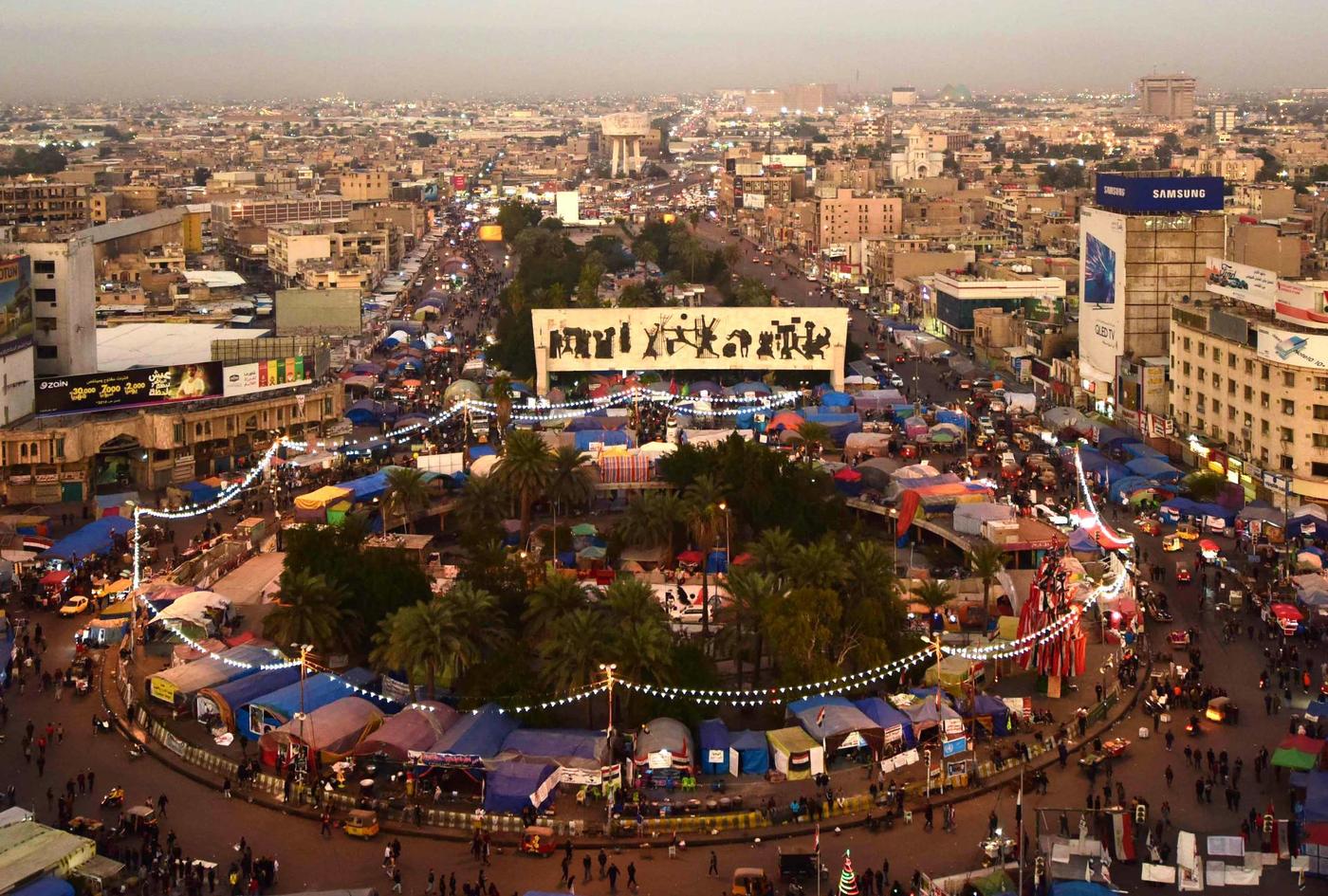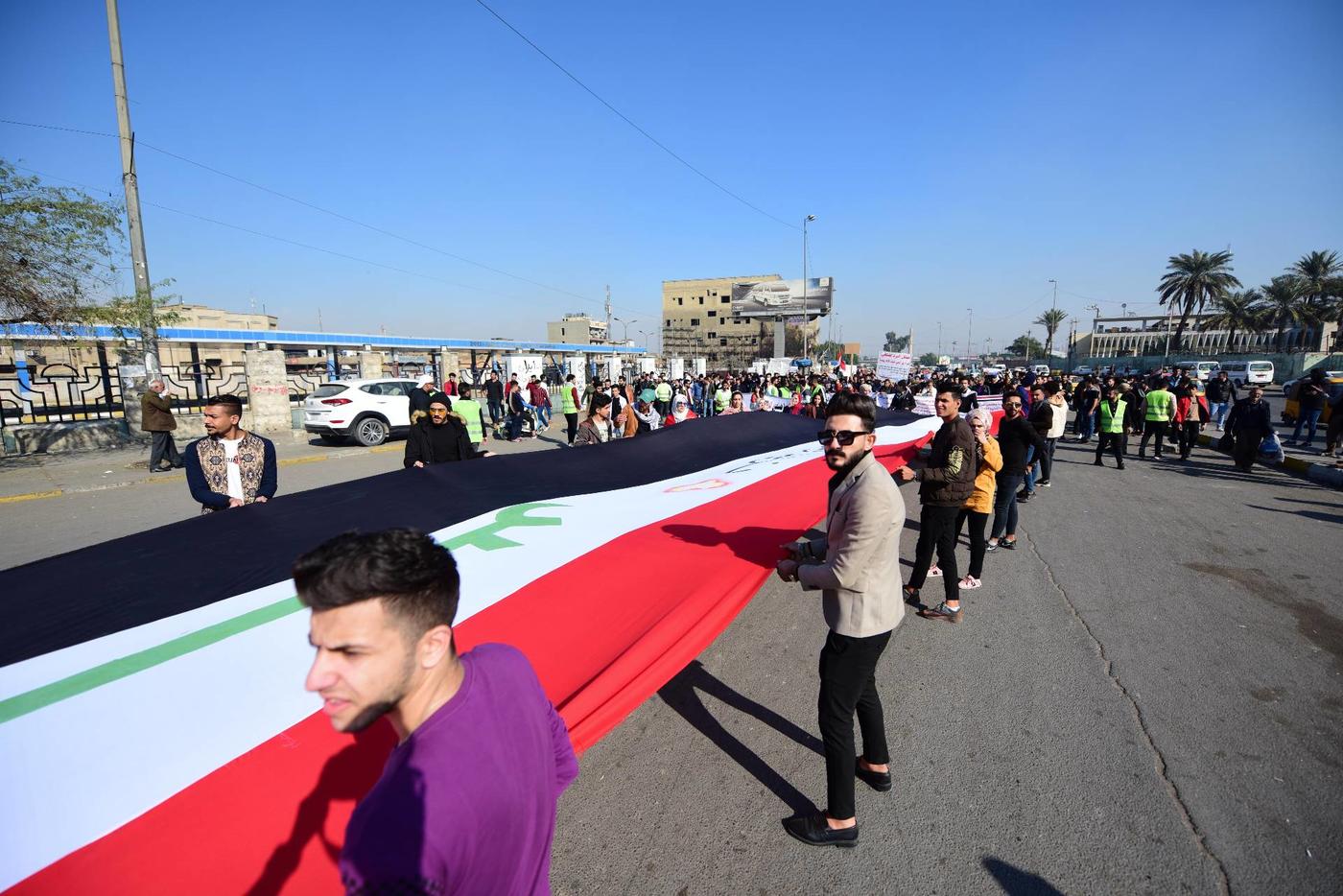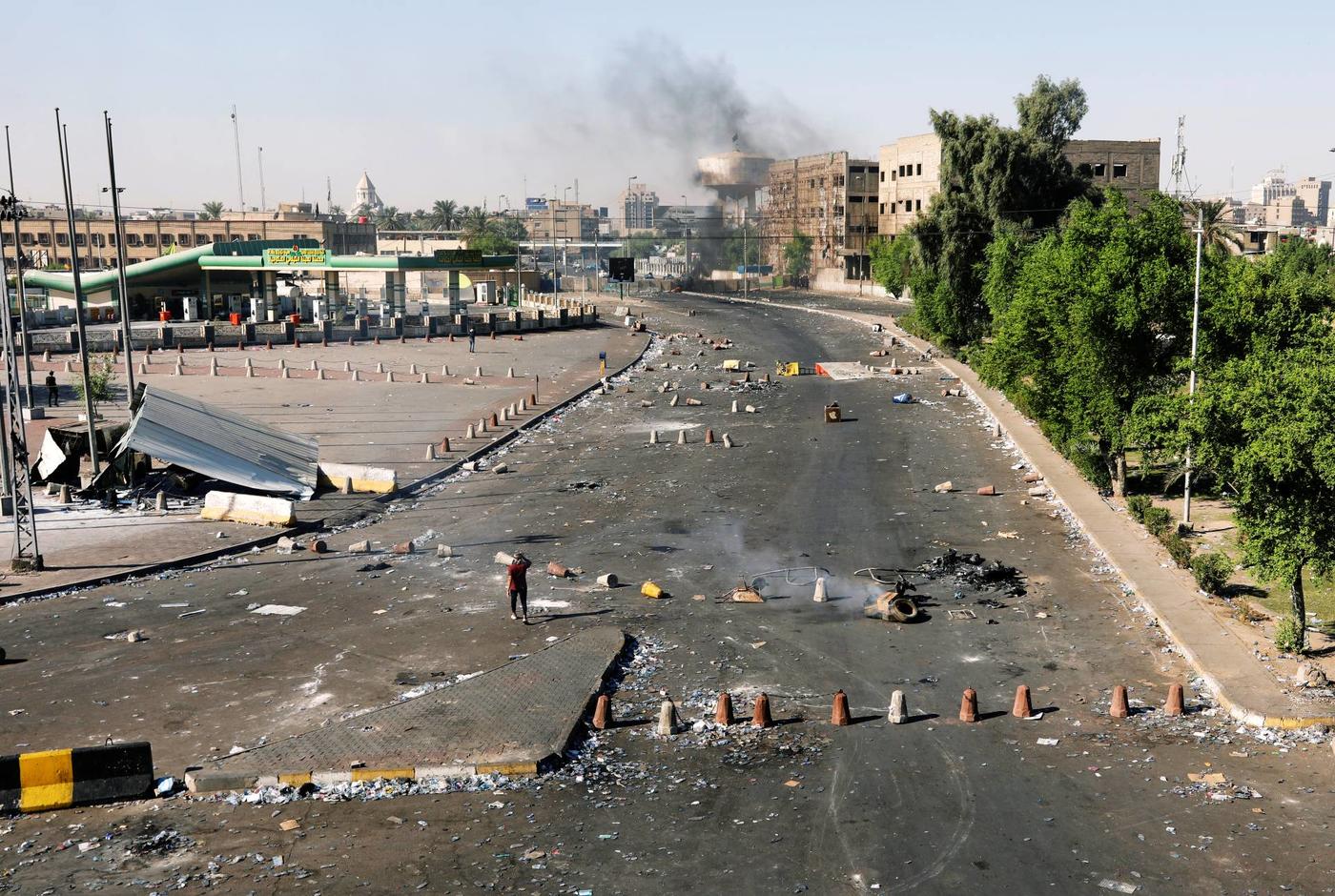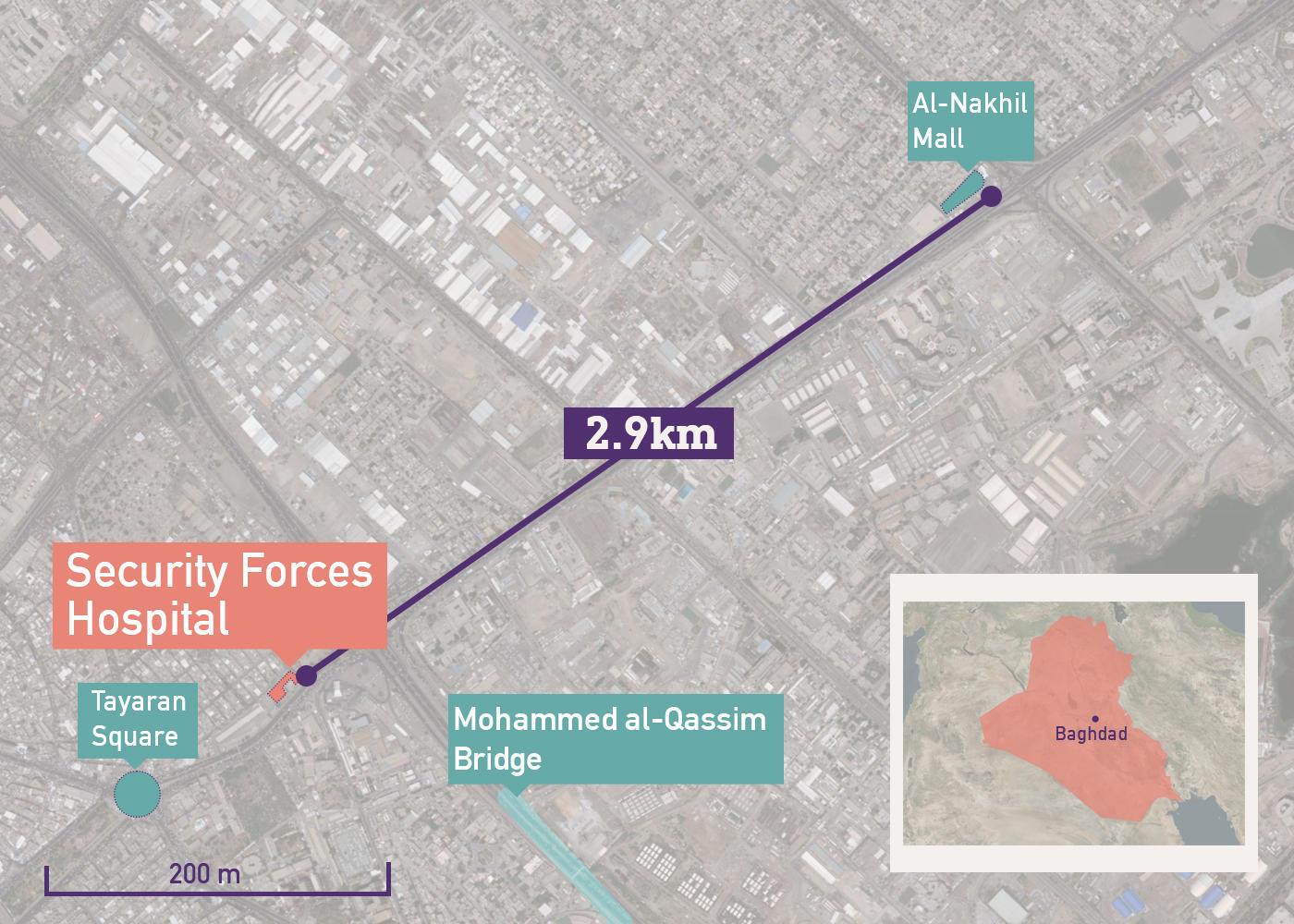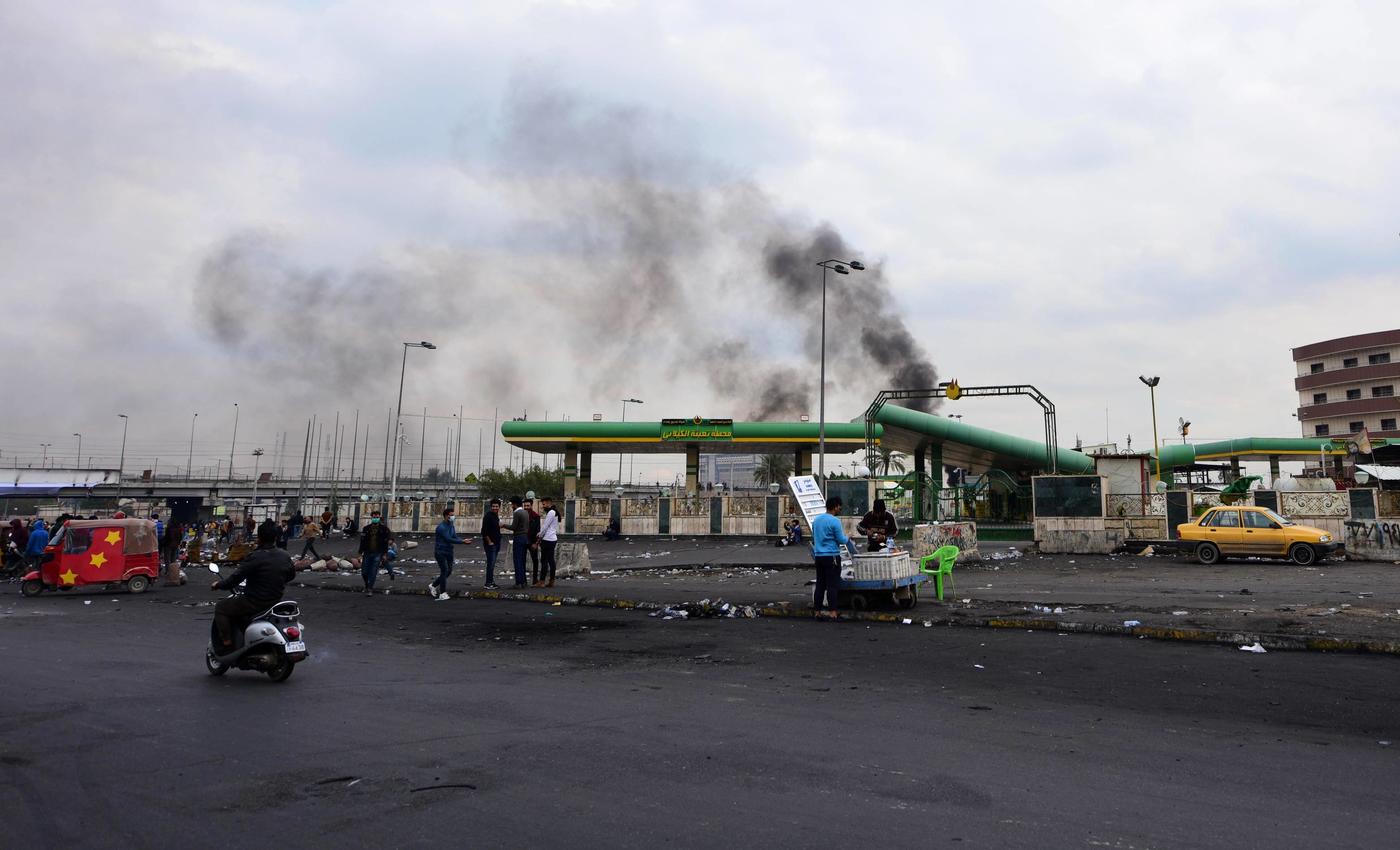
A massacre and a cover-up: How Baghdad protesters were gunned down by Iraqi forces
It was early morning on Friday 4 October 2019 when calm finally prevailed in the streets near eastern Baghdad’s upscale Al-Nakheel Mall.
Hours earlier, hundreds of protesters had filled the streets on the third day of mass anti-government demonstrations in the capital, as well as cities across the south, demanding the end of corruption, more jobs and improved public services.
Now dozens of protesters slept under the Mohammed al-Qassim Bridge, bedding down after security forces had prevented them from reaching Tahrir Square, the epicentre of the country-wide movement.
At half-past six, a yellow tuk-tuk pulled up by a blast wall which security forces had erected near a gas station to block the main road to the square. Inside were three passengers. Two left the vehicle carrying small blue backpacks, then broke the chains surrounding segments of the cement blast wall.
New MEE newsletter: Jerusalem Dispatch
Sign up to get the latest insights and analysis on Israel-Palestine, alongside Turkey Unpacked and other MEE newsletters
Awoken by the activity, some of the protesters gathered, hoping they now had a chance to reach their friends - and the square - through the new opening.
What happened next caught them unaware.
Suddenly, the tuk-tuk passengers lobbed Molotov cocktails over the wall and onto the security forces, before making a quick exit. Most of the protesters, still asleep, had no idea what had happened until “the gates of hell”, as one eyewitness described it, opened onto them and bullets started flying.
"The firing was intense and continuous, and only stopped for a few seconds from time to time," Talib Saad, 27, an activist who was at the scene, told Middle East Eye.
“We were facing inevitable death. When the shooting stopped for a few minutes, we ran to take shelter in the nearby Al-Nahdha car showrooms. Bullets were piercing their sandwich panel walls,” he said.
'The shooting lasted about half an hour. It was clear that they were shooting at us with automatic machine guns. Four of the protesters fell in front of me'
- Talib Saad, eyewitness
“The shooting lasted about half an hour. It was clear that they were shooting at us with automatic machine guns. Four of the protesters fell in front of me. There was no opportunity to evacuate them or even stop to see if they were still alive or dead.”
Rumours circulated among the protesters that unidentified snipers stationed above the mall had been picking off protesters during the mayhem.
In the hours and days that passed, Iraqi officials also told the public that unknown snipers on rooftops had targeted security forces and demonstrators “to incite sedition”. Four people, including two security personnel, had been killed in the area between Tayaran Square and the mall, according to official statements.
But the official narrative about the attack has never come close to explaining what actually happened.
The total number of victims, the manner of their deaths and the identification of the killers has never been disclosed - until now.
MEE has interviewed more than a dozen former and current civilian and military officials with direct knowledge of the investigation and examined official documents that have never been released to the public.
MEE has found that 32 protesters may have been killed in the attack near al-Nakheel Mall. Further, evidence seen by MEE has raised questions about whether the al-Nakheel attack was only a snapshot of systematic violence perpetrated by security forces in Baghdad over several days that October.
While government officials have continued to blame the al-Nakheel attack on unknown forces, sources tell MEE that investigators tasked by Prime Minister Adel Abdul Mahdi knew within 11 days exactly who was responsible.
Behind closed doors, the perpetrators were admonished and sent to fight Islamic State militants in Kirkuk, where officials hoped they would die and “push the incident into oblivion”. The government quietly offered financial compensation to families of those killed in the attack, but never clarified who was behind the killings.
Meanwhile, officials who knew what happened remained silent and, at multiple junctures, obstructed human rights and UN investigators from discovering the truth. And the families of the protesters killed that day - and the wider Iraqi public who have now seen around 600 protesters killed since that week - have been left in the dark.
“They killed my son. They killed Muqtada with a bullet to the head. I don't know until today who his killers are,” Abdul Razzaq Abdullah, whose 17-year-old son was shot on 4 October near the mall, told MEE this week.
"I want to know the killer so that I can rest."
Blast walls and firebombs
Iraq was roiling in October 2019. Tens of thousands of people flooded the streets of Baghdad and eight southern governorates, raging against poor basic life services, widespread corruption in state institutions and high unemployment.
There had been protests across Iraq before - but these were different. After years of accumulated frustration without seeing improvement in their daily lives, the Shia community exploded onto the streets against the Shia-led government.
The protests were hugely embarrassing to the government both because of how massive they were and also because of the anger of the Shia masses against Shia political forces.
The capital was the protest movement’s heartbeat and the greatest concern for the government of the prime minister and his allies. Youths swarmed in and around central Baghdad’s Tahrir and al-Khilani squares. Only the Tigris River separated the demonstrators from the fortified Green Zone, home to most Iraqi government departments and international diplomatic missions.
In response, the Baghdad Operations Command secured sensitive locations by dividing the city centre into several blocks. Each section was jointly run by local, anti-riot federal police, the Rapid Response forces, Iraqi army troops, the Commando Brigade of the Baghdad Operations Command and other supportive forces and security services.
The block extending from Tayaran Square to the al-Hamzah traffic intersection adjacent to al-Nakheel Mall, an area containing the ministries of interior, oil and transport, was one of the most sensitive.
Three days of bloody confrontations between security forces and demonstrators prompted authorities to cut off the main road leading to Tayaran Square - only about 300 metres from Tahrir Square - with concrete blocks that served as blast walls.
The security forces’ exact distribution was unknown, though the cordon they built was clear to all - and it was inevitable that troops and police would be stationed behind blast walls.
So when the tuk-tuk passengers lobbed firebombs over the wall, they had plenty of targets to hit. Two security personnel were killed and several military vehicles torched as a result, security officials told MEE.
And it’s from here that the official narrative and MEE’s findings diverge.
The official narrative
The Friday morning attack near al-Nakheel Mall was not the only protest that first week of October to turn fatal.
Hundreds of demonstrators were killed and wounded across Baghdad and the south, as the government oversaw a systematic crackdown that combined force with curfews, internet blockages and restricted access.
Most independent journalists and human rights observers were unable to get anywhere near the city squares, the focus for the protesters, which witnessed widespread killings, kidnappings and arrests.
Domestic and international pressure piled on Abdul Mahdi. On 12 October, he formed a supreme ministerial fact-finding committee and ordered an inquiry into the killings, including those near al-Nakheel Mall.
Ten days later, some of the committee’s findings were announced on the state-owned Iraqiya satellite channel.
One hundred and forty-nine civilians and eight security personnel had been killed in eight governorates due to the use of “excessive force and live ammunition” to quell the protests, the committee concluded.
Demonstrations in Baghdad alone accounted for 107 civilian deaths, most of them as a result of head wounds, the committee announced. However, it did not provide further details about what had happened in the capital - at least publicly.
Privately, however, ministerial investigators produced a 14-page report, which MEE has obtained, labelled “top secret” and dated 21 October 2019.
'It was a real massacre. There were no prior orders to use live ammunition, but an unqualified officer lost his nerve and started firing, so the others followed'
- senior security official
It noted that the largest number of deaths in Baghdad had happened in the area near al-Nakheel Mall.
The report also says that the committee found evidence “that sniper fire targeted protesters from the roof of a building in central Baghdad”.
There were indications, the report says, of “the existence of a sniper site in one of the structures of the buildings opposite a gas station in central Baghdad, and upon inspection of the site, several empty cartridges of a sniper weapon were found”.
No further details were provided about the building alleged, nor about the number or type of cartridges that its investigators found.
However, MEE saw an even earlier draft of the classified report. That version contains a paragraph making it clear that the building referenced in the final report was located near the area where the al-Nakheel attack occurred.
But what investigators avoided mentioning even in the early draft of the classified report was that their evidence only suggested a lone sniper.
“There was only one sniper. That's what our investigation revealed,” a former Iraqi minister and a key member of the supreme ministerial fact-finding committee told MEE.
“The strange thing is that we don't know yet who put him [the sniper] there and to which forces he belongs. All the field commanders denied having any connection with him or giving orders to him to be stationed there or to take part in the events.”
Despite this, sources informed about the attack tell MEE that Iraqi officials used the committee’s findings to push the idea that unknown snipers were behind the killings.
Lieutenant General Jalil al-Rubaie, the commander of Baghdad operations at the time, was among the first to officially promote the narrative of the unknown snipers.
The day after the attack, Rubaie told the leaders of the al-Karkh tribe that “a sniper was stationed in one of the capital's areas and targeted the demonstrators who went out to demand their rights”.
“The intelligence tried to arrest him, but he managed to escape to an unknown destination,” he said.
He was not alone in his assertions.
In a television interview weeks later, Najah al-Shammari, a former defence minister, said that "a third party was involved in killing protesters", alluding to the involvement of Iranian-backed armed factions.
A senior security official who saw footage of the al-Nakheel attack said the explanations were a convenient way to shut down further investigations.
“What was required was to cover up what happened. Blaming unknown snipers means hinting at the involvement of a party outside the equation [the demonstrators and the security forces],” he said.
“The atmosphere was fully prepared for the narration of the snipers and the protesters themselves, who were echoing it and confirming it in their testimonies.”
He added: "The aim was to blame the armed factions [supported by Iran], to shut out any demands that the real perpetrator be held accountable."
What really happened?
The gunmen who killed the protesters early on 4 October were not unknown snipers, but the Iraqi security forces tasked with protecting the area, MEE has been told.
After the tuk-tuk passengers threw the Molotov cocktails over the blast wall, soldiers reacted with frantic shooting, according to the senior security official who watched footage of the attack recorded on a surveillance camera.
“When some of the soldiers saw their colleagues burning in their vehicles, they lost their nerve and started firing hysterically and indiscriminately from machine guns installed on their vehicles,” he said.
“It was a real massacre. There were no prior orders to use live ammunition, but an unqualified officer lost his nerve and started firing, so the others followed.”
The force deployed at the scene, he added, was trained to fight in wars and had no experience with domestic security.
“It was certainly not qualified to deal with the demonstrators,” he said.
Most of the protesters were hit by indirect fire coming from a soldier stationed on top of a military vehicle with a medium-range machine gun, he said.
The senior security official’s account was corroborated by several eyewitnesses, three officers and two officials familiar with the results of the investigations, who all told MEE that automatic-weapon fire was responsible for the majority of casualties.
But it wasn’t the soldiers’ frantic shooting alone that inflicted such high casualties - but also the angle at which they were firing.
'You can't imagine how many governmental and non-state actors have colluded to cover up this incident," the official said bitterly'
- Senior security official
Officers told MEE that the types of vehicle-mounted machine guns used by Iraqi forces would “tear the target apart” if shot directly into a crowd.
Fired upwards at an angle of between 60 and 90 degrees, the shooting would be loud enough to scare away crowds, but not fatal, they said.
But the soldiers on 4 October, according to the senior security official, were not shooting directly at protesters, but at an angle of 30 to 45 degrees “and with the time, the hands of some of them would get tired and go lower”.
“This is the ideal firing angle [30-45 degree],” a military armour officer told MEE, explaining that the force of the bullets, when they hit their target, would be the same force as when they left the barrel of the machine gun. “So it will be fatal.”
And that’s what the senior security official witnessed in the footage.
“Most of the casualties that day were caused by bullets that fell, not from direct fire,” the senior security official said.
The senior security official’s account is consistent with the findings detailed in the private report of the supreme ministerial fact-finding committee, which pointed out that about 70 percent of the murdered protesters in Baghdad were hit in the head and chest areas.
A commissioner with the Iraqi High Commission for Human Rights (IHCHR) confirmed this detail based on the testimonies of physicians cooperating with them.
When the shooting ended, at least 18 protesters and two soldiers were dead, according to the senior security official who saw surveillance video of the attack. Dozens more were wounded.
Even at this stage, officials sought to cover up what had happened, victims’ relatives and physicians working in Baghdad emergency rooms told MEE.
The health ministry, they said, gave strict instructions to hospitals that victims should be denied forensic autopsies, meaning that details identifying the cause of death were forbidden from being included on death certificates.
The IHCHR commissioner told MEE that they were aware a massacre took place near al-Nakheel Mall but could not get any “concerted information” on what happened or the real number of casualties.
"The ministries of health and the interior refused to provide us with any statistics or details. They were not cooperative with us most of the time,” the commissioner said.
“While the official public position said that only four people were killed, including two security personnel, a physician working at Al-Kindi Hospital near the area called to tell us that they had received on that day 18 bodies, mostly killed by fatal injuries to the head and the upper parts of the body.”
The United Nations Assistance Mission for Iraq (UNAMI), the UN Security Council’s mission in Iraq set up in 2003 to support and advise the Iraqi government at its own request, investigated the incident but was also unable to establish more detail.
In May, UNAMI published its sixth report on human rights violations committed during demonstrations in Iraq, citing “an unidentified shooter, or shooters” behind the attack near the mall.
The exact number of casualties was unknown, UNAMI reported, but of the 107 protesters killed in Baghdad between the first and eighth of October 2019, the highest number of casualties occurred around the mall.
The mission noted without elaboration that it had encountered “significant challenges” in gathering information on the mall attack and several others “due to an environment of fear and secrecy surrounding the identity of the perpetrators”.
Explicit admission
While UN and human rights investigators strived in vain to identify the perpetrators, the government had already approved compensation packages for families of those killed during the attack, MEE was told.
In late October 2019, after the fact-finding committee finished its work, the prime minister’s cabinet passed Resolution 340, which classified the protesters killed near the mall among others killed that week as “victims of wrong military operations”, according to an official at the Foundation of Martyrs, a government department responsible for victims of banned Baath Party crimes, terrorism and military activity gone awry.
The foundation, for example, has compensated civilians who were killed and homeowners whose houses were damaged by Iraqi security forces or the US-led international coalition during the fight against IS.
The documents show that on 4 October, 32 people were recorded killed in Baghdad in areas mostly near al-Nakheel, not two as the Iraqi authorities have claimed
To fulfil Resolution 340, the Ministry of Health’s forensic medicine department eventually gave the foundation lists of demonstrators killed during the protests in October and November 2019 “because they were included in the compensation and privileges of the martyrs”, the foundation official said.
MEE has obtained copies of the lists, which cover deaths in October and November 2019 in Baghdad. Their authenticity has been confirmed by several government sources, including the foundation and the prime minister’s office.
They are the only official documents that have appeared to date containing details about how many protesters were killed, where they were killed and on what dates, their cause of death and the serial numbers of their death certificates.
The documents show that on 4 October, 32 people were recorded killed in Baghdad in areas mostly near al-Nakheel, not two as the Iraqi authorities have claimed over the past two years - or 18 as MEE’s senior security source believed.
But the lists also raise further questions about the killing of demonstrators beyond the Al-Nakheel attack in Baghdad during that first week in October.
Protesters' deaths classified as victims of wrong military operations, according to the lists seen by MEE, began on 1 October, the very first day of demonstrations.
The number of protesters who were killed and classified as victims of wrong military operations rises significantly from two on the first day to 24 on the third day then 32 on the fourth day and 18 on the fifth day.
Most of the victims were killed as a result of bullets to the head or the upper parts of the body, the lists record.
The majority of those killed were then handled by the Bab al-Sheikh and al-Saadoun police stations, which were responsible for the area extending from Tahrir Square to al-Ghilani gas station near al-Nakheel Mall.
The question that has emerged with urgency is whether the 4 October attack near al-Nakheel Mall was an isolated reaction to the killing of two soldiers or a snapshot of systematic violence that lasted for several days.
The senior security official who saw the footage of the attack near al-Nakheel says even he is not sure exactly when the killing started, or what set it off.
“My closest interpretation of what happened is that the soldiers were killed on the third of October, not the fourth as the military authorities announced at the time. That is, the massacre at al-Nakheel actually began on the third of October and lasted for three days," he said.
"You can't imagine how many governmental and non-state actors have colluded to cover up this incident," the official said bitterly.
The government’s payments to the families of killed protesters were an explicit admission that they had been killed by Iraqi security forces. But what no one has been told, including the victims’ relatives, is which forces exactly.
Who did it?
The mishmash of police units and military divisions swirling around the streets of Baghdad on that day makes pinning down who opened fire in the area near the mall extremely difficult.
MEE sought official comment on the exact number of victims of the al-Nakheel incident. It also sought further details from the government’s perspective.
More than a dozen senior officials who were involved in the investigative committees set up by the governments of Abdul Mahdi and his successor, Mustafa al-Kadhimi, declined to answer questions or claimed they were not authorised to disclose any details.
'Some things are better kept secret because revealing them would stir up sedition'
- Former Iraqi minister
But after interviews with more than a dozen former and current civilian and military officials with direct knowledge of the investigation, MEE has learned that the area between Tayaran Square and Al-Nakheel Mall was under the control of two main forces on the day of the attack.
They were the Commando Regiment of the Baghdad Operations Command and the 45th Infantry Brigade of the 11th Division - Iraqi Army, in addition to other security services.
According to these sources, soldiers in the Commando Regiment of the Baghdad Operations Command were wearing the uniforms of the Rapid Response Forces, who were not deployed in the area.
But witnesses, who had no idea about the uniform change, were convinced that the Rapid Response Forces had carried out the killings, a detail no one involved in the official investigations had disclosed until today.
Behind closed doors, however, the fact-finding committee formed by Abdul Mahdi was well aware of who was involved, MEE has learned.
After 11 days of investigation, it recommended on 22 October:
- the removal of 87 officers from their posts and their involvement in the attack registered in their records
- the dismissal of the Baghdad Operations Commander, his security assistant, the commander of the 11th Infantry Division - Iraqi Army, the commander of the 1st Division - Federal Police, and the commander of the 45th Infantry Brigade
- the removal of the commander of the 2nd regiment of the 45th Infantry Brigade, the command of the Commando Regiment of the 1st division - Federal Police from their posts, while referring them to military investigation boards
The committee handed over information and CDs containing evidence to the Supreme Judicial Council clarifying exactly what happened in Baghdad that week, including at al-Nakheel Mall.
What none of the committee members announced or revealed - and what everyone sought to hide with “strange complicity”, according to a senior military official familiar with the investigation - is that the two soldiers who were killed were members of the 45th Brigade of the 11th Infantry Division - Iraqi army.
Also not revealed until now is that those involved in the al-Nakheel Mall massacre were their comrades from the brigade.
MEE was told this by officers who were briefed on the findings of an investigation into the reasons for the sudden increase in the number of protesters killed in Baghdad carried out by Lieutenant-General Abdul-Amir al-Shammari, the current deputy commander of joint operations and a former general inspector of the Ministry of Defence.
Their testimonies were corroborated by a senior officer in the Rapid Response Forces and a key member of the supreme ministerial fact-finding committee, who also spoke to MEE.
“Some things are better kept secret because revealing them would stir up sedition,” a former minister and a key member of the ministerial fact-finding committee told MEE. “Announcing such matters will not solve the problem, but will only make it worse.”
He added: “What happened [at al-Nakheel Mall] was a very natural and expected reaction. The soldier treats any target in front of him as an enemy, so what can we expect when two of his colleagues are burned in front of him?
“What do we expect from a soldier we brought from the fronts and fierce fighting with IS, and we put him face to face with a protester who was throwing stones and Molotov cocktails at him?"
Accountability
Beyond the dismissals and disciplinary notes added to files, there was one further measure taken, according to the security official who watched the surveillance footage of the massacre.
Lieutenant-General Abdul-Amir Yarallah, who was the deputy commander of joint operations at the time, ordered the transfer of the entire 45th Infantry Brigade to Kirkuk as a “punishment”, the source said.
"Yarallah decided to punish them and send them to the battlefronts in Kirkuk to face death there in the fight with IS," the security official said.
The transfer decision, he said, caused a “sharp quarrel” between Yarallah and Lieutenant-General Othman al-Ghanimi, who was the army chief of staff at the time.
“Ghanimi refused to punish them, but Yarallah insisted on transferring them,” the source said.
MEE understands that the brigade was transferred to Kirkuk in November 2019. Neither Ghanimi nor Yarallah responded to requests for comment.
"The decision to transfer them was aimed at keeping them away and pushing the incident into oblivion, while they [members of the 45th Brigade] were pushed to death,” the source said.
He concluded sarcastically: “This is how we deal with our problems in this country, by recycling death and its causes.”
But relatives of those killed are demanding more. Several family members who spoke to MEE say they have filed cases against the government but their cases have been brushed aside.
Abdul Razzaq Abdullah, whose son Muqtada was killed on 4 October, is one of them.
“I filed a case against the government and the former prime minister [Adel Abdul Mahdi], [Faleh] al-Fayyad (the head of the Popular Mobilisation Authority), and all the gang members," he said.
“Muqtada was a child and I don't know what sin he committed to be killed in this hideous way."
This article is available in French on Middle East Eye French edition.
Middle East Eye delivers independent and unrivalled coverage and analysis of the Middle East, North Africa and beyond. To learn more about republishing this content and the associated fees, please fill out this form. More about MEE can be found here.


